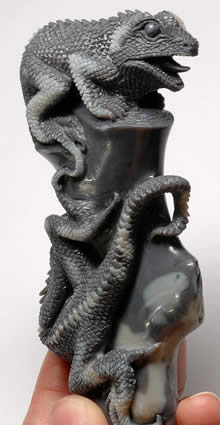Your Details
Your Details
GemSelect Newsletter - November 2009In our newsletter this month:
Color-Change Gems Back to Top
Gemstones with unusual optical qualities have held a special fascination for centuries. In gemology these are known as phenomenal gems. These effects include chatoyancy (the cat's eye effect), asterism (the star effect), adularescence (the shimmering effect, as in moonstone), play of color (as in opal) and iridescence (rainbow-like colors, as in labradorite). More recently there is another optical effect that has drawn a lot of attention - color change. Color change gemstones display different colors according to changes in lighting. The most famous of these is the rare and expensive alexandrite, a variety of chrysoberyl. However, color-change garnets and color-change sapphires have appeared on the market and show equally dramatic color changes. Some quite stunning color-change garnets have been discovered in Madagascar and East Africa in the last few years. Some of this material shows a marked change from greenish-brown to red-pink; others change color in various shades of orange or pink. We have even seen some pieces show a bluish-purple to red-pink change. We have been buying as many of the color-change garnet gemstones as we can find, since supply in these rare stones tends to be short-lived. A more subtle color change is found in the lovely pastel-colored diaspore. Mined from a single deposit in the mountains of Central Turkey, it is sometimes sold under the marketing name zultanite or csarite. Under natural or fluorescent light, diapsore has a kiwi green color, with flashes of yellow. Diaspore displays a champagne color under incandescent lighting, and when exposed to subdued lighting, such as candlelight, it has a pinkish color. Diaspore has reasonably good gemstone characteristics, with a hardness of 6.5 to 7 on the Mohs scale, about the same as peridot and tanzanite. It also has very good brilliance, with a high refractive index in the range between tanzanite and spinel. Gemologists have discovered some of the secrets of color-change gems. Apparently some gemstones have two, approximately equal-sized transmission windows. A red gemstone appears red because it absorbs all frequencies of light except for red. A gemstone that absorbs all frequencies except for blue and red light will appear blue when the light is rich in blue wavelengths (e.g., fluorescent light) and red when the light is rich in red wavelengths (e.g., incandescent lighting). The dual personality of color-change gems makes them fascinating to observe under changing conditions. Rare and Unusual Gems Back to Top

Carved Opal Iguana
Each month we focus on a rare and unusual gem from our inventory. This month we feature an exceptional, large opal gemstone: We often stock small gemstone carvings, but recently we've acquired some unusual large carvings produced by local artisans here in Thailand. These unique pieces, carved from a single block of material, are treasured by collectors. Our latest acquisition is this 670 carat carving of two iguanas. Executed with remarkable detail in Australian opal, this carving is almost 110 mm (4.33 inches) tall and would make a wonderful collector's piece or decorative gemstone ornament. Customer Questions Back to Top
Every month we answer questions of general interest from our customers. Please feel free to send your questions or suggestions to our support team at help@gemselect.com! Question
I received a certificate from the AIGS laboratory with my sapphire. It says "natural sapphire, no indication of heat process", but it doesn't give any clarity grade for my stone. Can you explain? Thank you so much for your excellent service. JM, USA.
Answer
The AIGS test reports certify the gemstone variety and any treatment. So your gem was certified as a natural sapphire that shows no evidence of heat treatment. The reason the report does not mention a clarity grade is because there is no standard for measuring clarity in colored gemstones like there is in diamonds. Some gem varieties, such as emerald, are almost always included. Others, such as aquamarine, chrysoberyl and blue zircon, are usually eye clean. Sapphire, ruby and garnets tend to be in the middle. Since there is no standard for grading clarity in colored gems, the major labs such as AIGS and GIA do not provide clarity grades for them.
Question
Is it true that harder gems are more brilliant? Why is that? CB, South Africa.
Answer
It is partly, but not entirely, true. The harder gems, such as sapphire (9 on the Mohs scale), ruby (9) and spinel (8) tend to have a high refractive index, which means more light is returned to the eye from inside the stone. Harder stones tend to take a very good polish, so they have an excellent luster as well. However, there are some gemstones that are relatively soft, but nonetheless have unusual brilliance. Examples include sphalerite (3.5 - 4) and sphene (5 - 5.5), both of which have a higher refractive index than sapphire or ruby. Some reasonably hard gems, such as topaz (8) and members of the beryl (7.5 - 8) family such as emerald and aquamarine have a relatively low refractive index.
Keep up with our new arrivals before they hit the newsletter by joining our thousands of fans and followers on our social networking pages. We love interacting with our customers - you can visit us on Tumblr, LinkedIn, Twitter, Facebook or Pinterest! To ensure you can receive our emails, please be sure to add help@gemselect.com to your list of safe contacts, or you add us into your email address book! Please feel free to contact us with any questions, comments and queries! We respond to each and every email we receive. Happy Gem Hunting! |
